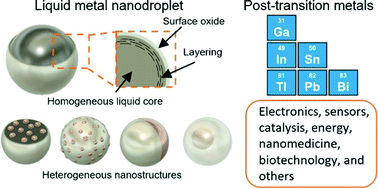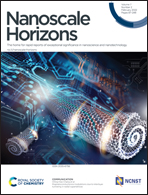Applications of liquid metals in nanotechnology
Abstract
Post-transition liquid metals (LMs) offer new opportunities for accessing exciting dynamics for nanomaterials. As entities with free electrons and ions as well as fluidity, LM-based nanomaterials are fundamentally different from their solid counterparts. The low melting points of most post-transition metals (less than 330 °C) allow for the formation of nanodroplets from bulk metal melts under mild mechanical and chemical conditions. At the nanoscale, these liquid state nanodroplets simultaneously offer high electrical and thermal conductivities, tunable reactivities and useful physicochemical properties. They also offer specific alloying and dealloying conditions for the formation of multi-elemental liquid based nanoalloys or the synthesis of engineered solid nanomaterials. To date, while only a few nanosized LM materials have been investigated, extraordinary properties have been observed for such systems. Multi-elemental nanoalloys have shown controllable homogeneous or heterogeneous core and surface compositions with interfacial ordering at the nanoscale. The interactions and synergies of nanosized LMs with polymeric, inorganic and bio-materials have also resulted in new compounds. This review highlights recent progress and future directions for the synthesis and applications of post-transition LMs and their alloys. The review presents the unique properties of these LM nanodroplets for developing functional materials for electronics, sensors, catalysts, energy systems, and nanomedicine and biomedical applications, as well as other functional systems engineered at the nanoscale.

- This article is part of the themed collections: Nanoscale Horizons 10th anniversary regional spotlight collection: Asia-Pacific and Nanoscale Horizons Most Popular 2022 Articles


 Please wait while we load your content...
Please wait while we load your content...